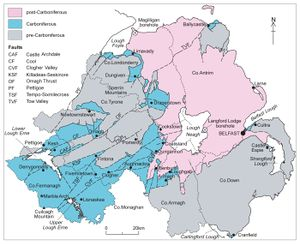Eastern Carboniferous outliers of Ballycastle, Cultra, Castle Espie and Carlingford, Northern Ireland
| Mitchell, W I (ed.). 2004. The geology of Northern Ireland-our natural foundation. Geological Survey of Northern Ireland, Belfast. |
W I Mitchell
Ballycastle








The Ballycastle area (P947815) is the only coastal location of Carboniferous coal seams in Ireland [1]. Coal mining is recorded in the 13th Century and continued until 1967 producing between 10–15 000 tons annually in the 18th Century (see Mineral resources article). Spectacular cliffs between Pans Rock [D 133 415] and Carrickmore [D 163 426] expose the upper part of the succession (see Mineral resources article, (P948060)). Strata become older from west to east due to minor faults that downthrow to the west [2]. Lithostratigraphical details for the lower part of the succession are from boreholes.
The lowest unit of the Ballycastle Group (P947928), the Eglish Sandstone Formation, rests unconformably on the Dalradian and is exposed at Murlough Bay. Grey mudstones 55m above the base in the stream [D 147 387] at Ballyberidagh North contain the miospores Spelaeotriletes arenaceus and Grandispora spinosa which first appear in the VF Biozone (Brigantian).
The Carey River Basalt Formation is exposed in the north-facing, roadside cliff [D 130 411] opposite Pans Rock. At Murlough Bay [D 198 420] two, crudely columnar, flows are exposed on the shore. At least 10 m of the Glenshesk Tuff Formation exposed in rock platforms on the shore [D 168 433] west of Fair Head include fireclay with plant remains and lycopod stumps with root systems (P947996). Black mudstone (oil shale) of the Murlough Shale Formation is exposed in rock platforms at Portnaloub [D 166 430].
The Ballyvoy Sandstone Formation is exposed in cliffs between Ballycastle and Fair Head. Although few coal seams are visible their stratigraphical position is well documented (P947900). The Carrickmore Shale Member consists of 13 m of grey mudstone with thin, banded ironstone and limestone and is exposed above the cliff-top waterfall [D 165 426] 250 m southeast of Carrickmore. The 20 m thick Main Limestone Member consists of mudstone and thin limestone. The limestone component, which consists of two or three closely spaced beds with a combined thickness of up to 2.4 m, is an important marker horizon and contains the Brigantian brachiopod Gigantoproductus giganteus. Exposures are confined to headlands between the North Star Colliery and Carrickmore and to the rock platform west of the North Star Dyke [D 148 419]. An ammonoid fauna including Sudeticeras adeps, of the late Brigantian P2b Biozone, occurs in calcareous sandstone 1.3 m above the top of the Main Limestone Member in cliffs [D 142 417] 250m NNE of Corrymeela. McGildowney’s Shale Member is 20 m thick, of which 15 m is lenticular sandstone that forms Pans Rock. The Viséan-Namurian boundary is located at the base of the Main Coal.
Cultra
The Holywood Group (P947929), which is exposed between Cultra and Craigavad (P947842) rests unconformably on Ordovician strata and is overlain by the Permian [3]. Late Courceyan-early Chadian miospores in the Ballycultra Formation [4] include Schopfites claviger and Auroraspora macra, of the late Tournaisian CM Biozone.
Castle Espie
The Strangford Group (P947927) comprises pink limestone with greenish and purplish red mudstone and was formerly exposed in quarries at Castle Espie (P947815). The quarries are flooded but blocks of grainstone on the shore [H 489 675] contain brachiopods, corals and trilobites. Their Brigantian age is based on the presence of foraminifera including Loeblichia paraammonoides.
Carlingford
The Carlingford Limestone Group comprises silty limestone and calcareous siltstone (P947815). East of Soldiers Point [J 261 105] the rocks are bioturbated with crinoid debris filling scour structures. The rocks contain numerous fossils including the brachiopod Delepinea carinata, corals Michelinia megastoma, Siphonodendron martini and Siphonophyllia garwoodi and foraminifera Glomodiscus and Paraarchaediscus at involutus stage, of mid- to late Arundian age. Calcareous sandstone, and sandy and oolitic limestone with ripple, parallel and cross-laminations, also contain pebbles of locally derived underlying rocks.
References
- ↑ Geological Survey of Northern Ireland 2002. Ballycastle, Northern Ireland Sheet 8. Solid Geology (second edition). 1:50 000. (Keyworth, Nottingham: British Geological Survey).
- ↑ Wilson, H E, and Robbie, J A. 1966. Geology of the country around Ballycastle. Memoir of the Geological Survey of Northern Ireland, Sheet 8 (Northern Ireland).
- ↑ Griffith A E, and Wilson, H E. 1982. Geology of the country around Carrickfergus and Bangor. Memoir of the Geological Survey of Northern Ireland, Sheet 29 (Northern Ireland).
- ↑ Clayton, G. 1986. Late Tournaisian miospores from the Ballycultra Formation at Cultra, County Down, Northern Ireland. Irish Journal of Earth Sciences, 8, 73–79.